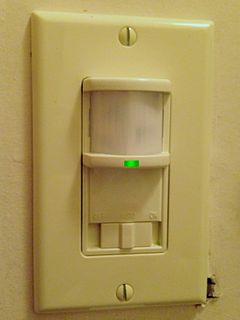Related Research Articles
A biosensor is an analytical device, used for the detection of a chemical substance, that combines a biological component with a physicochemical detector. The sensitive biological element, e.g. tissue, microorganisms, organelles, cell receptors, enzymes, antibodies, nucleic acids, etc., is a biologically derived material or biomimetic component that interacts with, binds with, or recognizes the analyte under study. The biologically sensitive elements can also be created by biological engineering. The transducer or the detector element, which transforms one signal into another one, works in a physicochemical way: optical, piezoelectric, electrochemical, electrochemiluminescence etc., resulting from the interaction of the analyte with the biological element, to easily measure and quantify. The biosensor reader device connects with the associated electronics or signal processors that are primarily responsible for the display of the results in a user-friendly way. This sometimes accounts for the most expensive part of the sensor device, however it is possible to generate a user friendly display that includes transducer and sensitive element. The readers are usually custom-designed and manufactured to suit the different working principles of biosensors.

Chemical, biological, radiological and nuclear defence are protective measures taken in situations in which chemical, biological, radiological or nuclear warfare hazards may be present. CBRN defence consists of CBRN passive protection, contamination avoidance, and weapons of mass destruction mitigation.

A security alarm is a system designed to detect intrusion, such as unauthorized entry, into a building or other areas such as a home or school. Security alarms used in residential, commercial, industrial, and military properties protect against burglary (theft) or property damage, as well as personal protection against intruders. Security alerts in neighborhoods show a connection with diminished robbery. Car alarms likewise help protect vehicles and their contents. Prisons also use security systems for the control of inmates.

Dangerous goods, abbreviated DG, are substances that when transported are a risk to health, safety, property or the environment. Certain dangerous goods that pose risks even when not being transported are known as hazardous materials. An example for dangerous goods is hazardous waste which is waste that has substantial or potential threats to public health or the environment.

A carbon monoxide detector or CO detector is a device that detects the presence of the carbon monoxide (CO) gas to prevent carbon monoxide poisoning. In the late 1990s Underwriters Laboratories changed the definition of a single station CO detector with a sound device to carbon monoxide (CO) alarm. This applies to all CO safety alarms that meet UL 2034 standard; however for passive indicators and system devices that meet UL 2075, UL refers to these as carbon monoxide detectors.

An occupancy sensor is an indoor motion detecting device used to detect the presence of a person to automatically control lights or temperature or ventilation systems. The sensors use infrared, ultrasonic, microwave, or other technology. The term encompasses devices as different as PIR sensors, hotel room keycard locks and smart meters. Occupancy sensors are typically used to save energy, provide automatic control, and comply with building codes.

An electronic nose is an electronic sensing device intended to detect odors or flavors. The expression "electronic sensing" refers to the capability of reproducing human senses using sensor arrays and pattern recognition systems.

Ultrasonic transducers and ultrasonic sensors are devices that generate or sense ultrasound energy. They can be divided into three broad categories: transmitters, receivers and transceivers. Transmitters convert electrical signals into ultrasound, receivers convert ultrasound into electrical signals, and transceivers can both transmit and receive ultrasound.

A gas detector is a device that detects the presence of gases in an area, often as part of a safety system. A gas detector can sound an alarm to operators in the area where the leak is occurring, giving them the opportunity to leave. This type of device is important because there are many gases that can be harmful to organic life, such as humans or animals.
Materials MASINT is one of the six major disciplines generally accepted to make up the field of Measurement and Signature Intelligence (MASINT), with due regard that the MASINT subdisciplines may overlap, and MASINT, in turn, is complementary to more traditional intelligence collection and analysis disciplines such as SIGINT and IMINT. MASINT encompasses intelligence gathering activities that bring together disparate elements that do not fit within the definitions of Signals Intelligence (SIGINT), Imagery Intelligence (IMINT), or Human Intelligence (HUMINT).
The Centre for Fire, Explosive and Environment Safety (CFEES) is an Indian defence laboratory of the Defence Research and Development Organisation (DRDO). Located in Timarpur, Delhi, its main function is the development of technologies and products in the area of explosive, fire and environmental safety. CFEES is organised under the Armaments Directorate of DRDO. The present director of CFEES is Rajiv Narang
Electrochemical gas sensors are gas detectors that measure the concentration of a target gas by oxidizing or reducing the target gas at an electrode and measuring the resulting current.

People sniffer was the field name for a series of U.S. Army issued "personnel detectors" used during the Vietnam War. The purpose was to detect enemy soldiers in hidden positions, which were often employed in the jungle combat conditions of Vietnam. The U.S. military used two different versions of the people sniffer, one backpack version and one helicopter-mounted version.

A rolling meth lab is a transportable laboratory that is used to illegally produce methamphetamine. Rolling meth labs are often moved to a secluded location where the strong, toxic fumes of methamphetamine manufacture cannot be detected and where the toxic manufacturing byproducts can be discarded. They are sometimes designed to manufacture the drug while the lab is traveling.

Lidar has a wide range of applications; one use is in traffic enforcement and in particular speed limit enforcement, has been gradually replacing radar since 2000. Current devices are designed to automate the entire process of speed detection, vehicle identification, driver identification and evidentiary documentation.
Robotic sensing is a subarea of robotics science intended to give robots sensing capabilities. Robotic sensing mainly gives robots the ability to see, touch, hear and move and uses algorithms that require environmental feedback or sensory data.
Cell CANARY is a recent technology that uses genetically engineered B cells to identify pathogens. Existing pathogen detection technologies include the Integrated Biological Detection System and the Joint Chemical Agent Detector.
RAE Systems, Inc., or RAE System by Honeywell, is a provider of wireless, gas and radiation detection instruments and systems that enable real-time safety and security threat detection to help mitigate risk, and protect workers, contractors, the public, and assets. RAE Systems is located in San Jose, California. The company was founded in 1991 by Robert I. Chen and Peter Hsi.
The Agentase Chemical Agent Detection (CAD) Kit, formerly known as the Fido C1 CAD Kit, is an enzyme-based chemical detection kit that contains six different sensors that are designed to detect specific chemical warfare agents (CWAs) and other toxic chemical contaminants at trace levels. The kit is provided in a small pouch and can detect the presence of the chemical agents within five minutes.
Workplace exposure monitoring is the monitoring of substances in a workplace that are chemical or biological hazards. It is performed in the context of workplace exposure assessment and risk assessment. Exposure monitoring analyzes hazardous substances in the air or on surfaces of a workplace, and is complementary to biomonitoring, which instead analyzes toxicants or their effects within workers.
References
- ↑ Glass, Jon (27 January 2007). "Responders get look at device that can detect meth fumes". Pilotonline.com. Retrieved 25 April 2015.
- ↑ "Chameleon® Chemical Detection Armband". Morphix Technologies. Retrieved 2022-08-29.
- ↑ "Morphix Technologies". Archived from the original on 2011-10-30. Retrieved 2011-11-06.
- ↑ "Morphix Technologies Virginia Beach". The Virginian-Pilot. Retrieved 2022-08-29.
- ↑ Law Enforcement Product News
- Connolly, Allison. "Beach Company Develops low-cost chemical detection device." McLatchy–Tribune Business News. 31 Oct. 2005. Web. 20 Oct. 2011.
- Glass, Jon W. "Responders Get First Look at Device that can Detect Meth Fumes." McLatchy-Tribune Business News. 27 January 2007. Web. 20 Oct. 2011.
- Otrovsky, Gene. "Morphix Chameleon Chemical Suicide Detection Kit." MedGadget. 28 Sept. 2011. Web. 20 Oct. 2011.
- Chameleon: Detecting the Invisible. Morphix Technologies. 2005. Web. 20 Oct 2011.
- "2007 Innovation Awards." Law Enforcement Product News. Dec 2007. Web. 24 Oct 2011.